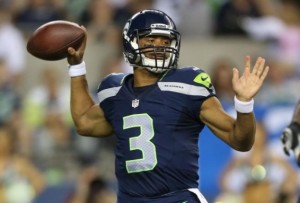Here’s how to read the Seahawks-Jaguars line. Seattle won at home against the Jaguars, 45-17, a 28-point margin of victory. The average lead for the Seahawks of every second of every game — the Game Script score — was 18.4 points. Seattle had 31 pass attempts against 35 runs, a 47% pass/run ratio. Jacksonville had 42 passes and 23 runs, a 64.6% pass/run ratio.
In all but one game, the team with the positive Game Script had a lower pass/run ratio, which makes perfect sense and is the reason I came up with the idea of using Game Scripts to evaluate offenses, teams, and coaches. The one exception isn’t very surprising: Cleveland, who just traded Trent Richardson, didn’t run as frequently as Adrian Peterson’s Vikings. The other game where this nearly happened was the Cincinnati/Green Bay game, where the Packers nearly won the Game Script battle. As a reminder, only one of the two teams playing had Aaron Rodgers.
Only two teams won in week three with a negative Game Script: the Titans and Dolphins. In Tennessee, Jake Locker led the first fourth quarter comeback of his career by driving his team 94 yards in the final 2:05 against the Chargers. In Miami, Ryan Tannehill’s game-winning drive was sandwiched around two key Falcons mistakes.
Leading by three with just under five minutes to go, Matt Bryant missed a 35-yard field goal. A short miss is never acceptable, although turning a three-point lead into a six-point one isn’t as valuable as you might think. Miami then drove down the field, which, as Bill Barnwell points out, set us up for a huge game mismanagement example from Falcons head coach Mike Smith.
The Dolphins faced 2nd and 10 at the Atlanta 29, trailing by 3, with 1:45 to go. Atlanta was still hoping to keep Miami off the scoreboard, of course, but a 21-yard pass to Charles Clay should have disabused them of that notion. At that point, Smith should have called a timeout, which would have left over 95 seconds on the clock. Miami scored a touchdown two plays later, so had Smith effectively used his timeouts, Atlanta (had events unfolded in exactly the same way) would have gotten the ball back with about 85 seconds remaining. Instead, the Falcons took possession with 38 seconds remaining. Matt Ryan’s good, but the odds of leading an 80-yard touchdown drive are significantly higher with 85 seconds than with 38 seconds.
How much higher? According to Brian Burke, the Falcons had only a 5% chance of winning; that more than triples to 17% if Atlanta takes possession with 1:25 remaining. Even that seems on the low side given the Falcons offensive prowess. And remember, three years ago, Ryan led just such a game-winning drive against the Ravens.
To be fair, had Atlanta called timeout after the Clay catch, it’s possible the Dolphins then try to milk the clock. But (1) there’s no downside to calling timeout in that situation, and (2) calling suboptimal plays (i.e., plays designed to waste clock instead of score) may have prevented Miami from scoring a touchdown. Smith seemingly didn’t call timeout either because he hadn’t thought through the situation or he didn’t want to show a lack of faith in his defense. Neither explanation is a good one, and this blunder could wind up costing his team a home — or any type of — playoff game.
Let’s also take a look at average field position, which is a descriptive stat. What do I mean by that? Here’s what Mike Tanier had to say about the Packers/Bengals game:
The Bengals defense may have had the best game in history for a unit that allowed 30 points. To be precise, the Bengals defense only allowed 23 points, with the Packers scoring one touchdown on a fumble return. But even the 23-point figure does not reflect how well the Bengals defense played. Turnovers gave the Packers the ball on the Bengals 26, 37, and 21-yard lines on three straight possessions. They settled for two field goals and a punt. The Packers got the ball on their own 40 and 42-yard lines late in the game. The Bengals defense responded with two interceptions.
Aaron Rodgers took four sacks and had at least three passes tipped at the line. The Packers were 4-of-13 on third downs and 0-of-2 on fourth downs. The best quarterback in the NFL had the ball in good field position all day but produced just 23 points. It was a tremendous effort by Carlos Dunlap, Michael Johnson, Leon Hall, Terence Newman, and many other Bengals defenders. The win bodes well for a team trying to prove it is “next step” worthy.
Well, we can use average field position data to show that Tanier’s intuition was correct. The average Packers offensive snap occurred at the Cincinnati 41-yard line, easily the worst situation any defense has faced this season. The table below shows the average yardline where each snap by each offense occurred in week three [1]Subject to the same caveats described in this post.; remember, having the ball on your opponent’s one-yard line gets recorded as a “99″ while having the ball at your own one is simply a “1.”
References
| ↑1 | Subject to the same caveats described in this post. |
|---|

